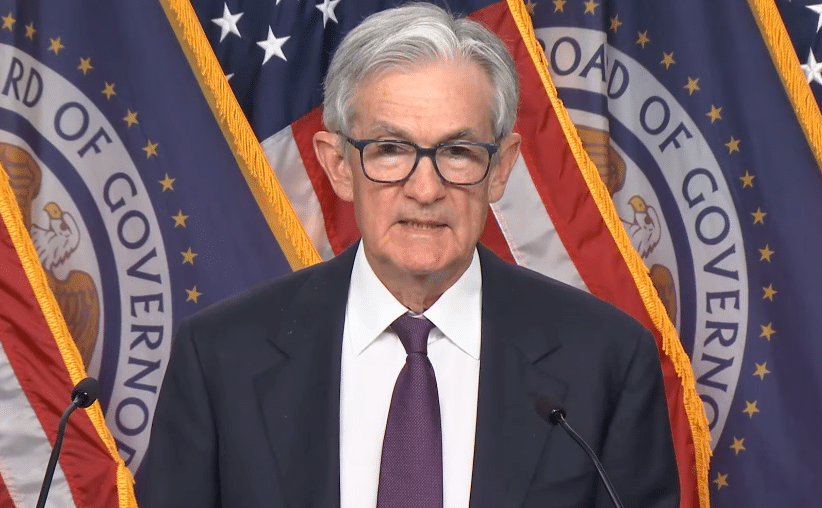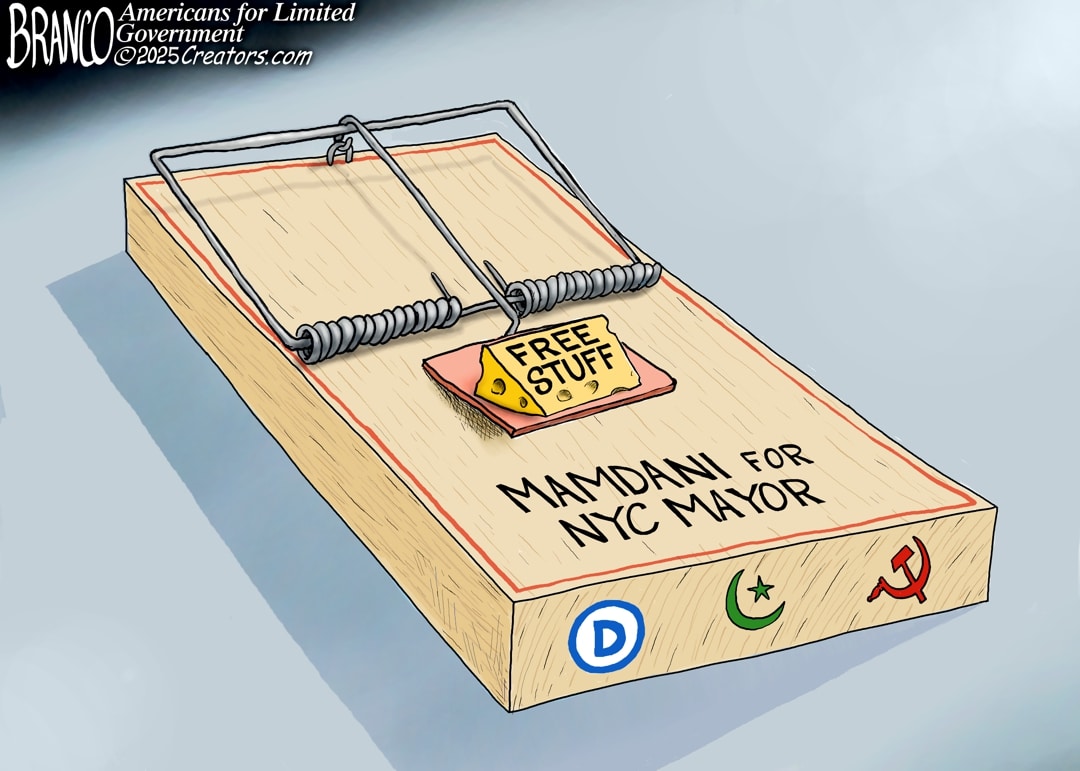
Oct. 30, 2025
Permission to republish original opeds and cartoons granted.
Fed Rate Cuts Usually Come Closer To A Recession As Fed Eases Citing Labor Market Concerns Without Jobs Data Amid Shutdown
|

|
|
The U.S. Federal Reserve on Oct. 29 once again voted to cut the federal funds rate — from a range of 4.25 percent to 4 percent, to a range of 3.75 percent to 4 percent — as the central bank cited ongoing labor market concerns despite no official unemployment data for the month of September from the currently defunded Bureau of Labor Statistics (BLS). The Fed stated, “Uncertainty about the economic outlook remains elevated. The Committee is attentive to the risks to both sides of its dual mandate and judges that downside risks to employment rose in recent months.” That’s not great news. Fed rate cuts usually come closer to recessions. But without the data being collected or reported during the government shutdown — BLS on an emergency basis published the September inflation report that showed a lower than expected 12-month total of 3 percent — it’s hard to say. Usually, inflation slowing down corresponds with unemployment increasing, and this cycle has been no different. After inflation peaked at 9.1 percent in June 2022 and began slowing, unemployment has ticked upwards correspondingly from 5.7 million in January 2023 to almost 7.4 million in August, a 1.6 million increase. So, maybe one month’s worth of data won’t make too much of a difference, whether it turns out to have been a big number of jobs lost or not in September. The Fed’s somewhat blind move to cut rates and stop asset sales appears prescient. With inflation slowing, the central bank is still anticipating labor market feedback as demand slows, which it has, with consumer credit briefly contracting at the beginning of 2025.
|
Saul Anuzis: Union Bosses Are Betraying The Working Class By Bankrolling Democrats
|

|
|
60 Plus Association President Saul Anuzis: “For decades, union bosses have claimed to represent America’s working class — to stand shoulder to shoulder with the men and women who keep our factories running, our roads built, and our economy strong. But a new report from Americans for Limited Government, ‘Union Bosses vs. MAGA’, exposes just how far union leadership has drifted from that mission. According to the ALG report, nearly 90 percent of all union political spending goes to Democrats and progressive causes. That’s not representation — that’s political control. These dues, collected from hardworking Americans who often have no say in how their money is spent, have become a partisan slush fund used to attack the candidates and the agenda supported by their own members. This includes public sector unions such as the National Treasury Employees Union, American Federation of State, County and Municipal Employees, the American Federation of Government Employees, the American Federation of Teachers, and the National Education Association, among others. Worse still, union bosses are now bankrolling the lawfare campaign against President Trump. The report reveals contributions of more than $100,000 to New York Attorney General Letitia James and $240,000 to Manhattan District Attorney Alvin Bragg — both leading the charge in politicized legal efforts targeting the former President. When workers’ dues are being weaponized to silence political opposition, it’s no longer about labor — it’s about power.”
|
Fed Rate Cuts Usually Come Closer To A Recession As Fed Eases Citing Labor Market Concerns Without Jobs Data Amid Shutdown

By Robert Romano
The U.S. Federal Reserve on Oct. 29 once again voted to cut the federal funds rate — from a range of 4.25 percent to 4 percent, to a range of 3.75 percent to 4 percent — as the central bank cited ongoing labor market concerns despite no official unemployment data for the month of September from the currently defunded Bureau of Labor Statistics (BLS).
The Fed stated, “Uncertainty about the economic outlook remains elevated. The Committee is attentive to the risks to both sides of its dual mandate and judges that downside risks to employment rose in recent months.” That’s not great news. Fed rate cuts usually come closer to recessions.
But without the data being collected or reported during the government shutdown — BLS on an emergency basis published the September inflation report that showed a lower than expected 12-month total of 3 percent — it’s hard to say.
Usually, inflation slowing down corresponds with unemployment increasing, and this cycle has been no different. After inflation peaked at 9.1 percent in June 2022 and began slowing, unemployment has ticked upwards correspondingly from 5.7 million in January 2023 to almost 7.4 million in August, a 1.6 million increase.
So, maybe one month’s worth of data won’t make too much of a difference, whether it turns out to have been a big number of jobs lost or not in September. The Fed’s somewhat blind move to cut rates and stop asset sales appears prescient. With inflation slowing, the central bank is still anticipating labor market feedback as demand slows, which it has, with consumer credit briefly contracting at the beginning of 2025.
And this has been true with the other four rate cuts, three in 2024 and another last month.
What’s different this time is the Fed is also ending its cycle of quantitative tightening: “The Committee decided to conclude the reduction of its aggregate securities holdings on December 1.”
That’s significant. Since March 2022 when the Fed finally exited the Covid-era zero percent bound, quantitative easing cycle where it piled on trillions of dollars to its holdings, to fight inflation, now the central bank is strongly signaling that the worst is long since past us. After buying an additional $3.3 trillion treasuries and $1.3 trillion mortgage-backed securities — causing a massive price spike in housing, thanks, Jay! — during and after Covid, the Fed reverted to selling. Since early 2022, it then sold $1.56 trillion of treasuries and about $620 billion of mortgage-backed securities.
The Fed’s current balance sheet now shows $4.2 trillion of treasuries and about $2.1 trillion of mortgage-backed securities.
It also puts a further exclamation point on the massive tariff inflation that never materialized despite hyperventilating statements panicking in April when President Donald Trump announced reciprocal tariffs with the rest of the world. All the panic managed to do was make savvy investors wealthier.
But, again, without any forthcoming data — all hope is basically lost there will ever be any October reports for jobs, prices or much of anything else — it’s hard to say what the economy will look like by year’s end. By taking these steps amid the shutdown, the central bank might be hoping for the best, and preparing for the worst.
Robert Romano is the Executive Director of Americans for Limited Government Foundation.
To view online: https://dailytorch.com/2025/10/fed-rate-cuts-usually-come-closer-to-a-recession-as-fed-eases-citing-labor-market-concerns-without-jobs-data-amid-shutdown/
Cartoon: Tasty Trap
By A.F. Branco

Click here for a higher level resolution.
To view online: https://dailytorch.com/2025/10/cartoon-tasty-trap/


Saul Anuzis: Union Bosses Are Betraying The Working Class By Bankrolling Democrats
By Saul Anuzis
For decades, union bosses have claimed to represent America’s working class — to stand shoulder to shoulder with the men and women who keep our factories running, our roads built, and our economy strong. But a new report from Americans for Limited Government, “Union Bosses vs. MAGA”, exposes just how far union leadership has drifted from that mission.
Today’s rank-and-file union members are the backbone of the MAGA coalition — patriotic Americans who value hard work, secure borders, lower costs, and fair wages. Between 58% and 60% of Teamsters surveyed supported Trump in the 2024 election. They know firsthand what economic stability means for their families. Yet while these workers overwhelmingly support policies that put their interests first, their union leadership is quietly spending their dues to fund a political machine that fights those very policies.
According to the ALG report, nearly 90 percent of all union political spending goes to Democrats and progressive causes. That’s not representation — that’s political control. These dues, collected from hardworking Americans who often have no say in how their money is spent, have become a partisan slush fund used to attack the candidates and the agenda supported by their own members. This includes public sector unions such as the National Treasury Employees Union, American Federation of State, County and Municipal Employees, the American Federation of Government Employees, the American Federation of Teachers, and the National Education Association, among others.
Worse still, union bosses are now bankrolling the lawfare campaign against President Trump. The report reveals contributions of more than $100,000 to New York Attorney General Letitia James and $240,000 to Manhattan District Attorney Alvin Bragg — both leading the charge in politicized legal efforts targeting the former President. When workers’ dues are being weaponized to silence political opposition, it’s no longer about labor — it’s about power.
This betrayal strikes at the heart of what the labor movement was supposed to represent. Unions once fought to protect jobs and ensure economic opportunity for working families. But the modern “Union Boss” class has become an arm of the progressive elite — disconnected from the day-to-day struggles of the people they claim to champion. Instead of fighting for lower energy costs, they back climate policies that drive prices through the roof. Instead of supporting tax relief, they push higher taxes that cut into take-home pay. Instead of defending border security to protect American jobs, they side with politicians who flood the labor market and drive down wages.
The hypocrisy is staggering. Union leaders talk about “fighting for fairness” while using mandatory dues to undermine the policies their members want. They speak about “standing up for workers” while bankrolling the very political agenda that makes it harder for those same workers to pay their bills.
The MAGA movement’s appeal among working-class Americans is no mystery — it’s about self-determination, economic dignity, and common sense. It’s about policies that put American workers ahead of global bureaucrats, energy independence ahead of foreign oil, and paychecks ahead of politics.
That’s why union members across the country are waking up to the disconnect. They realize their dues are being spent not to defend their interests, but to advance a political ideology they reject. And they’re demanding change — demanding transparency, accountability, and the right to decide where their money goes.
If unions want to regain the trust of their members, they need to stop acting as political enforcers and start acting as advocates again. That begins with ending the abuse of mandatory dues for partisan purposes, disclosing every political contribution, and ensuring workers have a voice in how their money is used.
America’s working class deserves better. They deserve leadership that fights for jobs, opportunity, and prosperity — not power, privilege, and politics. The choice for union leadership is clear: stand with the workers who make this country strong or keep serving the political elites who have forgotten them.
Because in the end, the true labor movement isn’t about party or ideology. It’s about people — the men and women who get up every day to build, drive, manufacture, and move America forward. It’s time their union leaders remembered that.
To view online: https://dailycaller.com/2025/10/24/union-bosses-working-class-uaw-teamsters-democrat-political-donations/
